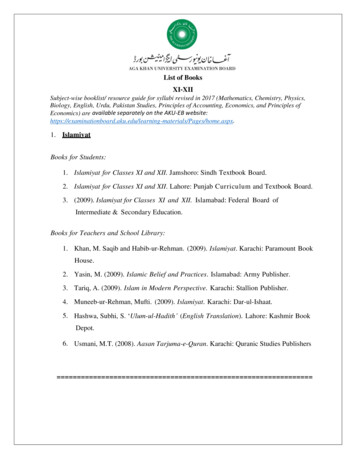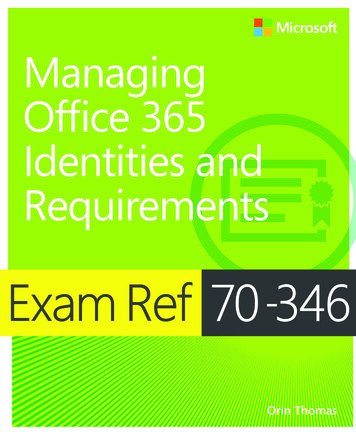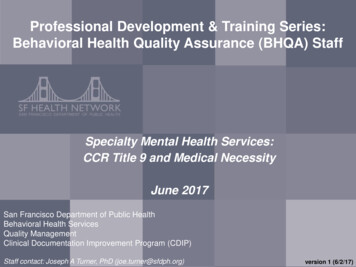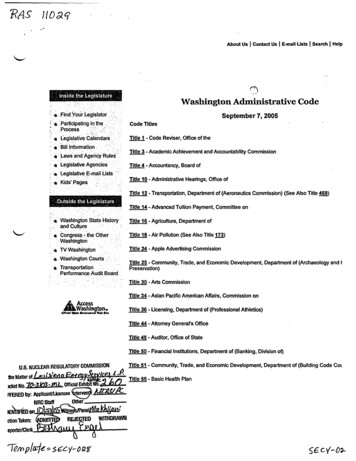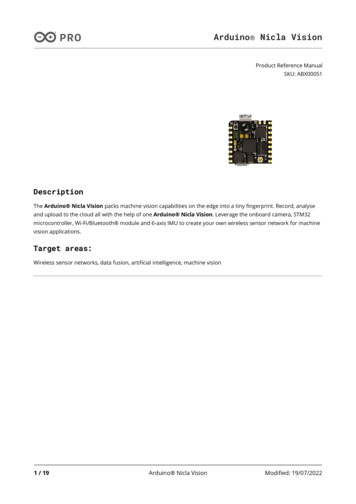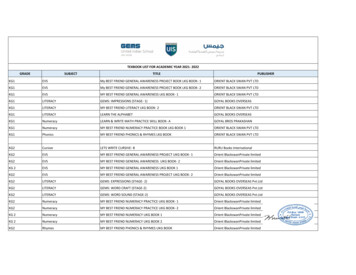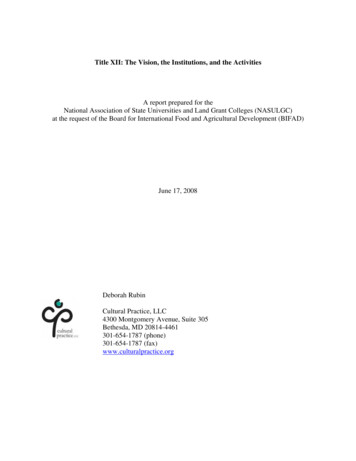
Transcription
Title XII: The Vision, the Institutions, and the ActivitiesA report prepared for theNational Association of State Universities and Land Grant Colleges (NASULGC)at the request of the Board for International Food and Agricultural Development (BIFAD)June 17, 2008Deborah RubinCultural Practice, LLC4300 Montgomery Avenue, Suite 305Bethesda, MD 20814-4461301-654-1787 (phone)301-654-1787 (fax)www.culturalpractice.org
AcknowledgementsThis report could not have been completed without the time and input of many people. Nearlyfifty people participated in phone or face to face interviews generally lasting about an hourand/or submitted comments and other documentation. The informants came from within USAID(current and former staff) and from the university community, as well as from USDA, severaluniversity associations, and other research organizations, and also included several formermembers of the Board for International Food and Development (BIFAD) and its subcommittee,Strategic Partnership for Agricultural Research and Education (SPARE). Despite the manydifferent opinions and occasional controversy that have surrounded the implementation of TitleXII since its inception in 1975, the interviewees contacted for this report were all generous withtheir time and their views. I thank all the people who spoke with me and those who responded tomy emails and phone calls.I also thank Robert Easter (University of Illinois), Chair of BIFAD, and the other members of theBoard, responded to the first draft of this report at their meeting in February 2008 with questionsand comments that have helped to improve the final product.I want to note the support of John Thomas, Director of the Office of Agriculture, USAID/EGAT,who supported the study and gave his permission for me to talk with as many members of hisstaff as needed, and who also facilitated contact with the Office of the General Counsel atUSAID to address several specific points of interpretation. Ron Senykoff, the current BIFADFederal Officer, was very supportive of this effort and provided insight, guidance, andenthusiasm. Tim Williams, current chairman of the Collaborative Research Support Program(CRSP) Council, provided important support in bringing questions to that council. Special thanksalso go to Jiryis Oweis, now an Agriculture Officer in USAID/EGAT/AGR but formerly a staffmember in the old BIFAD office at USAID. He found somewhere in his files several keyhistorical documents that enormously clarified to me how the earlier system of Title XIIprograms were managed. Susan Thompson, in USAID/EGAT/AGR, provided importantassistance in locating additional Title XII reports that filled in a great deal of the rest of thedocumentary record. John Yohe (University of Nebraska) and Raymond Miller (University ofMaryland) provided extremely useful feedback and needed support at various points in theprocess and deserve special recognition for their patience in responding to my many queries.Kerry Bolognese, Vice President for International Programs at the National Association of StateUniversities and Land Grant Colleges (NASULGC) managed the contractual agreements for thestudy and also facilitated the connections for several of the interviews. Tori Sickles,Administrative Assistant, helped with a number of logistical issues, always cheerfully and in atimely manner.The statements in the report do not represent USAID, NASULGC, BIFAD, or its subcommittees,nor are they the positions of any of the interviewees, but reflect my interpretations of theinformation reviewed. The responsibility for any errors is mine.Deborah RubinMay 12, 2008Draft final report submitted to NASULGC for BIFAD meeting –June 17, 2008ii
Executive SummaryTitle XII, “Famine Prevention and Freedom From Hunger,” is an amendment to the ForeignAssistance Act of 1961 that was initially signed into law in 1975 and amended in 2000. Thelegislation describes a “coordinated program” of several components that together have thepotential to enhance agricultural development across the globe. The legislation identifies aleading role for U.S. universities to work with their many partners to achieve the goals of“ensuring food security, human health, agricultural growth, trade expansion, and the wise andsustainable use of natural resources” – agriculture in all its dimensions – through research,education, extension/outreach, and policy formulation.Over the years, the scope and level of activities carried out by United States Agency forInternational Development (USAID) through U.S. universities that have been characterized as“Title XII activities” has declined dramatically. The early members of the Board for InternationalFood and Agricultural Development (BIFAD) had a broad and bold vision of their role and weresupported in that view by the USAID administration of the time. They envisioned a hugepotential in the application of university-led cutting-edge research and technical assistance insolving food and nutrition problems around the world.Notably over the last fifteen years the Board’s vision and involvement in agriculturaldevelopment has narrowed and USAID support has diminished in concert with shifts across thedevelopment assistance paradigm. Part of this decline is a function of the reduced fundingavailable for agricultural development and greater investment in health, HIV/AIDS, and othersectors; another factor is a change in USAID procurement processes that favors opencompetition and contracting rather than grants, raising questions about procurement sensitivityand potential conflicts of interest; and a third factor is decreased attention by USAID to globalresearch and sponsored training, two key elements characterizing earlier Title XII programs andtwo special skills associated with universities.The university context has also changed as they seek to deal with tight state budgets and newscientific and program priorities. Many offices of international agriculture have closed and staffconstraints affect both the ability of faculty and administrators to engage in the kind of activitiesonce supported under Title XII. It seemed appropriate, therefore, to revisit the subject of how toimplement Title XII in this new foreign assistance environment.This report reviews the characteristics of eligible Title XII universities and definition of Title XIIactivities as represented in the literature and as understood by a range of stakeholders in the U.S.agricultural community. It has been prepared for the Board for International Food andAgricultural Development (BIFAD) and executed under contract to the National Association ofState Universities and Land Grant Colleges (NASULGC). It builds on several earlier studies ofthe implementation of Title XII that speak to the long history and complicated relationship ofUSAID and the U.S. university community.Specifically, this report seeks to provide clarification on several issues: To explore which universities are eligible under Title XII;Draft final report submitted to NASULGC for BIFAD meeting –June 17, 2008iii
To offer a more detailed description of the defining characteristics of a Title XIIactivity; and, To recommend what BIFAD’s role might be in arbitrating any uncertainties in thosecategorizations.In preparation of the report, interviews were conducted with nearly fifty current and formerUSAID staff, BIFAD members, SPARE members, and university representatives as well as afew members of university associations, research organizations, and other federal agencies. Inaddition, a desktop review of Title XII reports, commissioned studies of U.S. university relationswith USAID, and scholarly literature on agricultural university involvement in internationalagricultural research, teaching, and outreach was undertaken.Key Findings Title XII, originally authorized in 1975 and amended in 2000, offers a bold and ambitiousvision supporting a broad definition of agriculture and agricultural research, teaching,extension, and policy development to prevent famine and achieve freedom from hunger. Itseeks to mobilize the use of U.S. universities in foreign assistance efforts in agriculture. Itsgoals remain critical in today’s assistance environment and the rising world food price crisis of2008. The Title clearly argues for a “coordinated program” to carry out the Agency’s work in theagriculture and environment sectors. It is envisioned as having multiple components that workin harmony, some of which are university-led and others not (see Sec. 296 (b)), towards thegoals of preventing famine and ending hunger. Historical documentation reveals that this coordinated program, from the outset, included notonly university-led activities but also support to the International Agricultural ResearchCenters (IARCs). The Title mentions a range of opportunities involving universities on theirown and with other partners as subgrantees or subcontractors within the university community,among the IARCs, with other Federal agencies, with non-governmental organizations (NGOs),and in the private sector. The work to develop and pass the 2000 amendment involved many players from both theuniversity community and from USAID. The history of that process, however, is poorlyrecorded and individual memories are contradictory, such that there exists a great deal ofmisinformation about the sequence of events and the decision-making process that surroundedit. No legislative report was prepared for Congress prior to its passage. Title XII establishes the BIFAD to “assist in the administration of programs authorized by thistitle” (see Sec. 298). In the past, BIFAD had a broad vision of its role as helping to shape theentire Agency agricultural portfolio, in order to better plan opportunities to support research,teaching, and extension and the involvement of university-led assistance. In recent years, theBoard’s responsibilities have been interpreted quite narrowly. The language in the Titleappears to support the broader view, such that BIFAD’s involvement relates to all of themultiple components of the coordinated program, including the work of the internationalDraft final report submitted to NASULGC for BIFAD meeting –June 17, 2008iv
agricultural centers as well as other efforts that the Agency supports in agricultural research,training, extension, and policy formulation. There is considerable misunderstanding among interviewees about the criteria for “eligibleuniversities” under Title XII. Some think it is only the 1862 and 1890 land grant universities.Others are aware that the 2000 amendment added the 1994 land grants. Many are unfamiliarwith or uncertain about the additional provision for involving “other eligible universities.” BIFAD is required by the Title to “develop and keep current a roster of universities.” This hasnot been done for some time. A provisional list is included as an appendix to this report. The Title XII legislation does not formally describe “a Title XII activity” or “a Title XIIproject” although it describes in general terms categories of effort to be pursued under thelegislation and the range of players who may participate. There was considerable disagreement among the interviewees about the content of the annualTitle XII report, in large part because of the confusion over the scope of Title XII and thedefinition of its activities. There was support for using the report as a vehicle for showcasingall of USAID’s agricultural work, both under Title XII and other efforts, but only if there was aclear separation in the report of these two types of programs and the funding provided forthem. Interviewees among the university community were concerned that recent reports gave afalse impression, particularly in the funding tables, that Title XII activities were receiving ahigher level of funding than they did in actuality. According to many interviewees, BIFAD does not currently have adequate resources, in staffor funding, to carry out the larger scope of work envisioned for it by Title XII.Recommendations to BIFAD1. Develop a “Guide to Title XII and BIFAD” to assist mission and bureau development of theTitle XII program, Title XII activities, and the mobilization of universities in USAIDdevelopment efforts in agriculture, broadly defined.2. Clarify the definition and type of Title XII activities, e.g.,: Title XII activities are initiated by or reviewed and approved by BIFAD (or its designatedsubcommittee/s or staff) prior to award for designation as appropriate under the Title XIIlegislation; and, Title XII activities are almost entirely implemented by eligible U.S. universities listed onthe BIFAD-established roster (although there are some exceptions discussed in the report),and, Title XII activities may be constituted as a grant, cooperative agreement, or a contract andfunded from any USAID account or operating unit (central or regional bureau or fieldmission); Title XII activities address one of the four objectives of the Title, specifically, to 1) carryout global research on problems affecting food, agriculture, forestry, and fisheries; 2)Draft final report submitted to NASULGC for BIFAD meeting –June 17, 2008v
improve human capacity and institutional resource development for the global applicationof agricultural and related environmental sciences; 3) provide agricultural development andtrade research and extension services in the United States and other countries to support theentry of rural industries into world markets; and, 4) provide for the application ofagricultural sciences to solving food, health, nutrition, rural income, and environmentalproblems, especially such problems in low-income, food deficit countries.In short, a Title XII activity is one that contributes to the goals of the Title (Sec. 296 (a)) thatis implemented by or through an eligible U.S. university and which has been reviewed andapproved by BIFAD. Activities carried out by “partners” independently of an eligible U.S.university would not be considered Title XII activities, although their efforts might be part ofthe coordinated program described under Title XII.3. Since it is a requirement of the legislation, BIFAD is advised to arrange for thereestablishment of the “eligible university” roster and to define criteria for eligibility. Thiswill require some discussion among U.S. universities, USAID, and other interested parties oncriteria for eligibility. One option is simply to refer back to the USDA-maintained lists of1862, 1890, and 1994 institutions and the NOAA-maintained list of Sea Grant Colleges. Analternative is to establish USAID-specific criteria, such as:o being named in the key legislation noted in Title XII (amended 2000) (seeAppendix 6);o meeting agreed-upon indicators of “demonstrable capacity” in the followingareas: teaching, such as having a degree program in one or more of keyagricultural/NRM-related science (and social science) disciplines; research, such as having an established record of receipt of researchfunding and publications on research topics in one of more keyagricultural/NRM-related science (and social science) disciplines; and extension (including outreach) activities in the agricultural sciences, suchas having an established extension service, having a outreach programinvolving agricultural producers, processors, traders, or policymakerso meeting agreed-upon indicators of being able to “contribute effectively to theattainment of the objectives of this title,” such as offering capacity in areas otherthose listed above or having key individual scientists (faculty or graduatestudents) whose skills would enhance a specific activity.4. Initiate a process for engaging the universities and USAID on establishing a process forapplication to the roster and criteria for determining the basis forqualification/disqualification.5. Initiate discussion with USAID and the universities on the scope and content of the Title XIIreport, which is required under the legislation to detail the Title XII activities over theprevious year and projecting five years into the future. The report is also required to detailthe activities of BIFAD itself as well as its reaction to the activities report. Reporting onDraft final report submitted to NASULGC for BIFAD meeting –June 17, 2008vi
funding for Title XII activities should be clearly separated from discussions of other USAIDagricultural programs.Draft final report submitted to NASULGC for BIFAD meeting –June 17, 2008vii
AcronymsADSAMRBIFADBIFADECAutomated Directive System (USAID’s operations manuals)Administrative Management ReviewBoard for International Food and DevelopmentBoard for International Food and Agricultural Development and EconomicCooperationCGIARConsultative Group on International Agricultural ResearchCRSPCollaborative Research Support ProgramHBCUHistorically Black Colleges and UniversitiesHEDHigher Education for DevelopmentIARCInternational Agricultural Research CenterLDCLess Developed CountryJCADJoint Committee on Agricultural DevelopmentJCARDJoint Committee on Agricultural Research and DevelopmentJCCJoint Career CorpsJEMJoint Enterprise ModeJRCJoint Research CommitteeLWALeader with Associate AwardMOUMemorandum of UnderstandingNASULGC National Association of State Universities and Land Grant CollegesNGONon-Governmental OrganizationRIRRegistry of Institutional ResourcesSPAREStrategic Partnership for Agricultural Research and EducationTSMTechnical Support to MissionsUSUnited StatesUSAIDUnited States Agency for International DevelopmentUSDAUnited States Department of AgricultureUSIDCAUnited States International Development Cooperation AgencyDraft final report submitted to NASULGC for BIFAD meeting –June 17, 2008viii
Table of ContentsAcknowledgementsPageiiExecutive SummaryiiiAcronymsviI.Introduction1II.Title XII’s Bold Vision: Building on University Scientific Expertise toBenefit Development1III.What is an Eligible Title XII “Institution”?13IV.Defining a Title XII Activity15V.Conclusions and Recommendations23BibliographyAppendicesAppendix 1: Scope of WorkAppendix 2: MethodologyAppendix 3 Provisional List of Title XII Eligible UniversitiesDraft final report submitted to NASULGC for BIFAD meeting –June 17, 2008ix
Title XII: The Vision, the Institutions, and the ActivitiesI.IntroductionThis report reviews the characteristics of eligible Title XII universities and definition of Title XIIactivities as represented in the literature and as understood by a range of stakeholders in the U.S.agricultural community. It has been prepared for the Board for International Food andAgricultural Development (BIFAD) and executed under contract to the National Association ofState Universities and Land Grant Colleges (NASULGC). 1Title XII, “Famine Prevention and Freedom From Hunger,” is an amendment to the ForeignAssistance Act of 1961 that was initially signed into law in 1975 and amended in 2000. Thelegislation describes a “coordinated program” of several components that together have thepotential to enhance agricultural development across the globe. A range of institutions andpartners are described as participating in this “coordinated program,” but the legislationidentifies a leading role for the U.S. universities to achieve the goals of “ensuring food security,human health, agricultural growth, trade expansion, and the wise and sustainable use of naturalresources” – agriculture in all its dimensions – through research, education, extension/outreach,and policy formulation.The impetus for this study has been growing for several years. The relationship between the U.S.university community – and particularly the agricultural universities – and the United StatesAgency for International Development is a complicated one and has already been discussed anddissected by many people, both scholars and practitioners. 2 This study builds on their earlierwork to present options for BIFAD to consider in more clearly defining definition of a “Title XIIactivity,” and the related questions of the scope of the Title XII program and the identification ofTitle XII institutions.II.Title XII’s Bold Vision: Building on University Scientific Expertise to BenefitDevelopmentThe legislation referred to as “Title XII” among those in the U.S. agricultural community 3 is anambitious document. Looking at both its history and its current wording, it is also a complexdocument, and not without ambiguities and some possible internal contradictions.1Since April 2004, NASULGC has had a grant from the United States Agency for InternationalDevelopment (USAID) to provide logistical and other support to the work of BIFAD, including subcontracting out various research and analytical reports.2See listings in bibliography for documents by Richard Bissell (2006), Helen Gunther (2006), Miller andRubin (2003), Sherper (2004), Salt (2003), and the BIFAD-approved CRSP Guidelines (2005).3In this report, the phrase “the U.S. agricultural community” refers to institutions with interest andexpertise in the agricultural sciences and agri-business, including those in higher education, the privatesector, and the non-governmental organizations (NGO) and among the agencies of the Federalgovernment which are involved in international agricultural development, such as the United StatesAgency for International Development (USAID) and the United States Department of Agriculture(USDA), among others.Draft final report submitted to NASULGC for BIFAD meeting –June 17, 20081
It offers a bold vision of a world of abundant and safe food and healthy people, in which naturalresources are sustainably managed, and trade among nations boosts prosperity, particularlyamong the now impoverished. The Title XII vision finds solutions to the development problemsof hunger, malnutrition, and poverty in the scientific expertise of U.S. universities and theirpartners to carry out research, education, and extension efforts, building on the cutting-edgecapabilities of higher education in this country. It asks that universities be more effectivelyengaged in the larger agricultural development program. Encouraging the involvement ofuniversities is a central part of the legislation and the one on which documentation andstakeholder interviews agree.To mobilize that expertise, the amendment states that United States Agency for InternationalDevelopment USAID), in consultation with and in consideration of the advice and guidance ofthe Board of International Food and Agricultural Development (BIFAD), whose members areappointed by the President of the United States and drawn from the US university community aswell as the private sector.The legislation, however, also states that the goal of defeating hunger cannot be met without acoordinated program (see Sec. 296 (b) and Figure 1 below) with multiple components, includingthe efforts of a wide group of players including the international agricultural research centers,contract research, and collaborative research support programs, as well as other governmentagencies. The coordinated program also involves other functions such as dissemination ofresearch results.In responding to the interviews for this paper, many have asked “why?” Why spend more timeand money on yet another study on implementing Title XII? Previous studies have not yetchanged the terms of the debate or provided recommendations, whether good or not so realistic,that have been implemented with any success. Anger and frustration have been expressed byinterviewees from all quarters at the amount of time that USAID staff and university faculty andadministrators, as well as private sector and non-governmental organization (NGO)representatives have spent wrestling with a range of Title XII issues. They also point to declininglevels of funding for agriculture since the 1980s and the changing environment of internationaldevelopment and the multiplication of players that hinders cooperation, especially since 2001,between USAID and the U.S. university community. And all these points have been documentedand discussed, with little progress, over the past twenty-five (and sometimes more) years.There are, however, a number of reasons why it is worth another effort to address the thornyissues of Title XII implementation, including the practical considerations that: Title XII is law. In the past six months, a new food crisis has been developing, called a “food price crisis” thathas led to food riots and rising prices, and which begs for a coordinated and thoughtfulresponse from leading agricultural experts in the U.S. Lack of knowledge, mistrust, and differing interpretations about the content and implicationsof Title XII hinders the ability of USAID and as well as of the U.S. university community andits partners to have useful discussions on program issues or to take appropriate action afterdeliberation, wasting participants time and scare resources.Draft final report submitted to NASULGC for BIFAD meeting –June 17, 20082
In recent years, the varied (mis)understandings about Title XII have affected the requiredannual reporting to Congress, since there is not agreement over the scope and allocation offunding to the program. The cast of players in international development has increased significantly since the lastcomprehensive assessment of Title XII, with implications for the role of the universities andtheir relationships to the Agency. The context within USAID is also changed and that has affected staff responsibilities, levelsof program funds, and development priorities. BIFAD and its sub-committees, such as the Strategic Partnership for Agricultural Researchand Education (SPARE), would both benefit from agreement on expectations andresponsibilities.The “declaration of policy” of the start of Title XII (amended 2000) states that the “United Statesshould mobilize the capacities of the United States land-grant universities, other eligibleuniversities, and public and private partners of universities” to carry out a range of activities,including research, human and institutional capacity-building, extension, and the application ofagricultural sciences to improve human health, nutrition, environment, and rural incomeproblems (Sec. 297). Sherper (2004: 4) notes the shift in the 2000 amendment from“strengthening” the universities to “mobilizing” them to achieve the program goals.There is broad agreement among respondents as well as in the literature that Title XII calls for: Achievement of the goals of the legislation of “ensuring food security, human health,agricultural growth, trade expansion, and the wise and sustainable use of natural resources”(Sec 296 (a)); The establishment of BIFAD; and, The submission of an annual report on Title XII activities.Beyond that, the legislation offers many possible interpretations and there is considerabledisagreement over other points. Among the interviewees, there was a range of opinionsexpressed about: The role of research in agricultural development today; The appropriateness and practicality of working with universities under current USAIDprocurement procedures; The extent to which the goals of Title XII are to be accomplished only through universities,with or without their partners, or whether Title XII also encompasses the work of the IARCs; The ability of Title XII to be implemented without an increased staff presence, whether inUSAID or in another organization; How or whether to distinguish between universities and their partners in a definition of “TitleXII institutions”; The definition of Title XII activities; The content of Title XII reports to Congress; and The appropriate role of BIFAD and its success in carrying out that role.Draft final report submitted to NASULGC for BIFAD meeting –June 17, 20083
A History of Title XIIIn the over 30 years since Title XII was first passed, many of the original players have retired ordied, and those currently in positions of authority over the program are not all familiar with theshifts in scope and implementation that have occurred. A brief history of Title XII follows, toprovide a common understanding of some the major events and shifts in oversight andadministration of the program over time.Even before Title XII was originally passed in 1975, there had been a high degree of universityinvolvement in international agricultural efforts, funded by AID, in the 1960s. Writing in theearly 1960s, for example, Johnson noted two areas of university expertise particularly suited tointernational agricultural development. He wrote that university faculty and staff have expertise“in widely diversified disciplines vital to rural development,” and that they also excel in trainingothers who would then be able to teach, carry out research, or serve in government positions andother types of public service to address rural development (1964: 1110).In the early 1970s, however, general reductions in the AID budget reductions contributed to a dipin funding for universities engaged in development work overseas (GAO 1981: 3), and the desireto increase both the level and quality of U.S. university involvement in agricultural assistanceprograms was an important core of the effort to draft Title XII. Equally important, however, wasthe goal “to help AID improve its capability to deliver quality technical assistance” (GAO 1981:1). These goals were envisioned as being synergistic – that to achieve agricultural developmentgoals overseas, not only did USAID need to get bolster its technical knowledge with input fromUniversity scientists, but also that university systems needed support, example, in the adaptationof US research in developing country conditions or for building capacity in key skill areas (e.g.,regional knowledge or language facility). This vision of a synergistic relationship wascharacterized as the “Title XII partnership.”In the early years of Title XII implementation, there was real hope that the goals of “partnership”could be realized. Immediately
National Association of State Universities and Land Grant Colleges (NASULGC) . 2008 . Deborah Rubin . Cultural Practice, LLC . 4300 Montgomery Avenue, Suite 305 . Bethesda, MD 20814-4461 . 301-654-1787 (phone) 301-654-1787 (fax) www.culturalpractice.org . constraints affect both the ability of faculty and administrators to engage in the .




